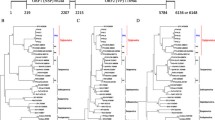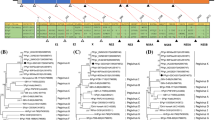Abstract
Ungulate protoparvovirus 1, also known as porcine parvovirus 1 (PPV1), is considered to be one of the major causes of reproductive failure in pig breeding herds. Other parvoviruses have also been identified in pigs, including ungulate tetraparvovirus 3, or PPV2, ungulate tetraparvovirus 2, or PPV3, and ungulate copiparvovirus 2, or PPV4, but their significance for pigs is unknown. In the present study, the prevalence of PPV1-4 was investigated using a total of 231 lung and serum samples collected from slaughterhouses in 13 provinces throughout Vietnam. The overall prevalence was 54.5% (126/231) for PPV1, 28.0% (65/231) for PPV2, 17.7% (41/231) for PPV3, and 7.8% (18/231) for PPV4. While PPV1 and PPV2 were found in 11 provinces, PPV4 was detected in only three provinces. Co-circulation of PPV1, PPV2 and PPV3 was frequently observed, with PPV1/PPV2 coinfection predominating, with 20.8% (48/231). All four PPVs were detected together in only one sample from Thua Thien Hue. Three nearly complete PPV4 genome sequences of 5,453 nt were determined and deposited in the GenBank database. Alignment and comparison of the three genome sequences showed 99.5-99.6% nucleotide sequence identity, and the deduced amino acid sequences of open reading frames 1-3 were 99.6-99.9% identical to each other, 98.9-99.3% identical to those of other Vietnamese strains and 99.4-99.7% identical to those of Chinese strains). Phylogenetic analysis further confirmed a close relationship between Vietnamese and Chinese PPV4 strains. These results are the first to report the prevalence of PPV1, PPV2, PPV3, and PPV4 and nearly complete genomic sequences of PPV4 in pigs from slaughterhouses in Vietnam.


Similar content being viewed by others
References
Molitor TW, Joo HS, Collett MS (1983) Porcine parvovirus: virus purification and structural and antigenic properties of virion polypeptides. J Virol 45:842–854
Bergeron J, Hebert B, Tijssen P (1996) Genome organization of the Kresse strain of porcine parvovirus: identification of the allotropic determinant and comparison with those of NADL-2 and field isolates. J Virol 70:2508–2515
Tattersall P, Kerr JR, Cotmore SF, Bloom ME, Linden RM, and Parrish CR (2006) The evolution of parvovirus taxonomy. In: Parvoviruses (ed), p 10
Cheung AK, Wu G, Wang D, Bayles DO, Lager KM, Vincent AL (2010) Identification and molecular cloning of a novel porcine parvovirus. Arch Virol 155:801–806
Wilhelm S, Zimmermann P, Selbitz HJ, Truyen U (2006) Real-time PCR protocol for the detection of porcine parvovirus in field samples. J Virol Methods 134:257–260
Walker PJ, Siddell SG, Lefkowitz EJ, Mushegian AR, Adriaenssens EM, Dempsey DM, Dutilh BE, Harrach B, Harrison RL, Hendrickson RC, Junglen S, Knowles NJ, Kropinski AM, Krupovic M, Kuhn JH, Nibert M, Orton RJ, Rubino L, Sabanadzovic S, Simmonds P, Smith DB, Varsani A, Zerbini FM, Davison AJ (2020) Changes to virus taxonomy and the Statutes ratified by the International Committee on Taxonomy of Viruses (2020). Arch Virol 2020:1–12
Mayr A, Mahnel H (1964) Cultivation of hog cholera virus in pig kidney cultures with cytopathogenic effect. Zentralbl Bakteriol Orig 195:157–166
Mengeling WL, Lager KM, Vorwald AC (2000) The effect of porcine parvovirus and porcine reproductive and respiratory syndrome virus on porcine reproductive performance. Anim Reprod Sci 60–61:199–210
Hijikata M, Abe K, Win KM, Shimizu YK, Keicho N, Yoshikura H (2001) Identification of new parvovirus DNA sequence in swine sera from Myanmar. Jpn J Infect Dis 54:244–245
Lau SKP, Woo PCY, Tse H, Fu CTY, Au WK, Chen XC, Tsoi HW, Tsang THF, Chan JSY, Tsang DNC, Li KSM, Tse CWS, Ng TK, Tsang OTY, Zheng BJ, Tam S, Chan KH, Zhou B, Yuen KY (2008) Identification of novel porcine and bovine parvoviruses closely related to human parvovirus 4. J Gen Virol 89:1840–1848
Xiao CT, Gimenez-Lirola LG, Jiang YH, Halbur PG, Opriessnig T (2013) Characterization of a novel porcine parvovirus tentatively designated PPV5. PLoS ONE 8:e65312
Ni J, Qiao C, Han X, Han T, Kang W, Zi Z, Cao Z, Zhai X, Cai X (2014) Identification and genomic characterization of a novel porcine parvovirus (PPV6) in China. Virol J 11:203
Palinski RM, Mitra N, Hause BM (2016) Discovery of a novel Parvovirinae virus, porcine parvovirus 7, by metagenomic sequencing of porcine rectal swabs. Virus Genes 52:564–567
Schirtzinger EE, Suddith AW, Hause BM, Hesse RA (2015) First identification of porcine parvovirus 6 in North America by viral metagenomic sequencing of serum from pigs infected with porcine reproductive and respiratory syndrome virus. Virol J 12:170
Cui J, Fan J, Gerber PF, Biernacka K, Stadejek T, Xiao CT, Opriessnig T (2017) First identification of porcine parvovirus 6 in Poland. Virus Genes 53:100–104
Ouh IO, Park S, Lee JY, Song JY, Cho IS, Kim HR, Park CK (2018) First detection and genetic characterization of porcine parvovirus 7 from Korean domestic pig farms. J Vet Sci 19:855–857
Xing X, Zhou H, Tong L, Chen Y, Sun Y, Wang H, Zhang G (2018) First identification of porcine parvovirus 7 in China. Arch Virol 163:209–213
Bovo S, Mazzoni G, Ribani A, Utzeri VJ, Bertolini F, Schiavo G, Fontanesi L (2017) A viral metagenomic approach on a non-metagenomic experiment: Mining next generation sequencing datasets from pig DNA identified several porcine parvoviruses for a retrospective evaluation of viral infections. PLoS ONE 12:e0179462
Cadar D, Lorincz M, Kiss T, Novosel D, Podgorska K, Becskei Z, Tuboly T, Csagola A (2013) Emerging novel porcine parvoviruses in Europe: origin, evolution, phylodynamics and phylogeography. J Gen Virol 94:2330–2337
Cadar D, Dan A, Tombacz K, Lorincz M, Kiss T, Becskei Z, Spinu M, Tuboly T, Csagola A (2012) Phylogeny and evolutionary genetics of porcine parvovirus in wild boars. Infect Genet Evol 12:1163–1171
Nguyen H, Tran DT (2000) Survey of some factors related to reproductive disorders in sows in Long An province. In: University of Agriculture and Forestry, Ho Chi Minh City, Vietnam
Huang L, Zhai SL, Cheung AK, Zhang HB, Long JX, Yuan SS (2010) Detection of a novel porcine parvovirus, PPV4, in Chinese swine herds. Virol J 7:333
Csagola A, Lorincz M, Cadar D, Tombacz K, Biksi I, Tuboly T (2012) Detection, prevalence and analysis of emerging porcine parvovirus infections. Arch Virol 157:1003–1010
Cadar D, Csagola A, Kiss T, Tuboly T (2013) Capsid protein evolution and comparative phylogeny of novel porcine parvoviruses. Mol Phylogenet Evol 66:243–253
Saekhow P, Ikeda H (2015) Prevalence and genomic characterization of porcine parvoviruses detected in Chiangmai area of Thailand in 2011. Microbiol Immunol 59:82–88
Saekhow P, Kishizuka S, Sano N, Mitsui H, Akasaki H, Mawatari T, Ikeda H (2016) Coincidental detection of genomes of porcine parvoviruses and porcine circovirus type 2 infecting pigs in Japan. J Vet Med Sci 77:1581–1586
Cui J, Biernacka K, Fan J, Gerber PF, Stadejek T, Opriessnig T (2017) Circulation of porcine parvovirus types 1 through 6 in serum samples obtained from six commercial polish pig farms. Transbound Emerg Dis 64:1945–1952
Afolabi KO, Iweriebor BC, Obi LC, Okoh AI (2019) Prevalence of porcine parvoviruses in some South African swine herds with background of porcine circovirus type 2 infection. Acta Trop 190:37–44
Ndze VN, Cadar D, Csagola A, Kisfali P, Kovacs E, Farkas S, Ngu AF, Esona MD, Dan A, Tuboly T, Banyai K (2013) Detection of novel porcine bocaviruses in fecal samples of asymptomatic pigs in Cameroon. Infect Genet Evol 17:277–282
Altschul SF, Gish W, Miller W, Myers EW, Lipman DJ (1990) Basic local alignment search tool. J Mol Biol 215:403–410
Hall T (1999) BioEdit: a user-friendly biological sequence alignment editor and analysis program for Windows 95/98/NT. Nucl Acids Symp Ser 41:95–98
Kumar S, Stecher G, Li M, Knyaz C, Tamura K (2018) MEGA X: molecular evolutionary genetics analysis across computing platforms. Mol Biol Evol 35:1547–1549
Tamura K, Nei M (1993) Estimation of the number of nucleotide substitutions in the control region of mitochondrial DNA in humans and chimpanzees. Mol Biol Evol 10:512–526
Streck AF, Homeier T, Foerster T, Fischer S, Truyen U (2013) Analysis of porcine parvoviruses in tonsils and hearts from healthy pigs reveals high prevalence and genetic diversity in Germany. Arch Virol 158:1173–1180
Sun J, Huang L, Wei Y, Wang Y, Chen D, Du W, Wu H, Liu C (2015) Prevalence of emerging porcine parvoviruses and their co-infections with porcine circovirus type 2 in China. Arch Virol 160:1339–1344
Chung HC, Nguyen VG, Huynh TM, Park YH, Park KT, Park BK (2020) PCR-based detection and genetic characterization of porcine parvoviruses in South Korea in 2018. BMC Vet Res 16:113
Opriessnig T, Xiao CT, Gerber PF, Halbur PG (2014) Identification of recently described porcine parvoviruses in archived North American samples from 1996 and association with porcine circovirus associated disease. Vet Microbiol 173:9–16
Serena MS, Cappuccio JA, Metz GE, Aspitia CG, Dibarbora M, Calderon MG, Echeverria MG (2019) Detection and molecular characterization of porcine parvovirus in fetal tissues from sows without reproductive failure in Argentina. Heliyon 5:e02874
Afolabi KO, Iweriebor BC, Okoh AI, Obi LC (2019) Increasing diversity of swine parvoviruses and their epidemiology in African pigs. Infect Genet Evol 73:175–183
Novosel D, Cadar D, Tuboly T, Jungic A, Stadejek T, Ait-Ali T, Csagola A (2018) Investigating porcine parvoviruses genogroup 2 infection using in situ polymerase chain reaction. BMC Vet Res 14:163
Saekhow P, Mawatari T, Ikeda H (2014) Coexistence of multiple strains of porcine parvovirus 2 in pig farms. Microbiol Immunol 58:382–387
Sliz I, Vlasakova M, Jackova A, Vilcek S (2015) Characterization of porcine parvovirus type 3 and porcine circovirus type 2 in Wild Boars (Sus Scrofa) in Slovakia. J Wildl Dis 51:703–711
Tregaskis PL, Staines A, Gordon A, Sheridan P, McMenamy M, Duffy C, Collns PJ, Mooney MH, Lemon K (2020) Co-infection status of novel parvovirus’s (PPV2 to 4) with porcine circovirus 2 in porcine respiratory disease complex and porcine circovirus-associated disease from 1997 to 2012. Transbound Emerg Dis 2020:16
Acknowledgements
This study was funded by the Vietnam’s National Foundation for Science and Technology (NAFOSTED) under grant number 106-NN.05-2015.62. TO was supported by the Biotechnology and Biological Sciences Research Council (BBSRC) through the Roslin Institute Strategic Programme “Control of Infectious Diseases” (BBS/E/D/20002173 and BBS/E/D/20002174). Thanks also to NAFOSTED funding for my two-month research at the Roslin Institute, and to Mrs. Holly Steven for her support during my stay at the Roslin Institute. The authors thank Ashley Mattei for critical review of this manuscript.
Author information
Authors and Affiliations
Contributions
NTDT, responsible for conception this study, laboratory work, and drafting the manuscript). NTT, sample collection from central provinces and assisting with genotyping experiments. TQD, sample collection from northern provinces and DNA extraction. DVAK, sample collection from southern provinces. TO, manuscript review; DTNT, assisting with sequencing. All authors read and approved the final manuscript.
Corresponding author
Ethics declarations
Conflicts of interest
The authors declare that they have no competing interests.
Additional information
Handling Editor: Ana Cristina Bratanich.
Publisher's Note
Springer Nature remains neutral with regard to jurisdictional claims in published maps and institutional affiliations.
Supplementary Information
Below is the link to the electronic supplementary material.
Rights and permissions
About this article
Cite this article
Thuy, N.T.D., Trung, N.T., Dung, T.Q. et al. First investigation of the prevalence of parvoviruses in slaughterhouse pigs and genomic characterization of ungulate copiparvovirus 2 in Vietnam. Arch Virol 166, 779–788 (2021). https://doi.org/10.1007/s00705-020-04928-5
Received:
Accepted:
Published:
Issue Date:
DOI: https://doi.org/10.1007/s00705-020-04928-5




